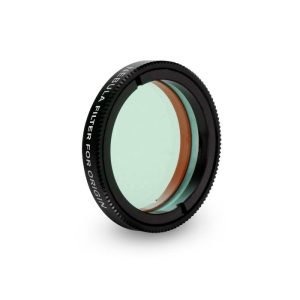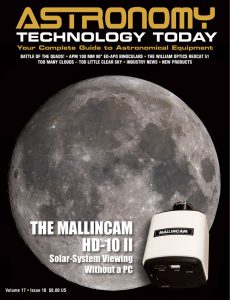The Nebula Filter for Celestron Origin enhances the views and images of nebulae when using the Celestron Origin especially from urban and suburban skies. The filter blocks light pollution, boosts image contrast and darkens the sky background for noticeably better images as it transmits only the key Hα-Hβ-OIII wavelengths from emission nebulae, making their colors “pop” from the dark background.
 The transmission spectrum for the Nebula Filter is 85% or greater at key wavelengths (486nm, 496nm/501nm, 656nm) and less than 0.5% transmission elsewhere. As a narrowband filter, it blocks much of the visible spectrum and only lets these specific wavelengths through. Because of this, the filter should not be used while observing or imaging broadband emission objects, such as galaxies and star clusters. For those objects, best results are obtained by removing the nebula filter and reinstalling Origin’s clear optical window.
The transmission spectrum for the Nebula Filter is 85% or greater at key wavelengths (486nm, 496nm/501nm, 656nm) and less than 0.5% transmission elsewhere. As a narrowband filter, it blocks much of the visible spectrum and only lets these specific wavelengths through. Because of this, the filter should not be used while observing or imaging broadband emission objects, such as galaxies and star clusters. For those objects, best results are obtained by removing the nebula filter and reinstalling Origin’s clear optical window.
The Nebula Filter is perfect for imaging emission nebulae like the North America Nebula (NGC 7000), Lagoon Nebula (M8), Orion Nebula (M42), the Carina Nebula (NGC 3372) and a number of others. As the filter offers maximum light transmission in the key Hα-Hβ-OIII wavelengths it produces high contrast for emission nebulae like these.
As the Celestron team notes, “Unlike similar filters with narrower bandpasses, this filter was engineered specifically to work with Origin’s fast f/2.2 optics to allow more of the light you want while suppressing the light you don’t. Simply remove the optical window from Origin’s filter drawer and insert the Nebula Filter. It won’t disrupt the optical path of your Origin, and no additional adapters are needed.”
You can learn more about the Nebula Filter for Celestron Origin here.

 And to make it easier for you to get the most extensive news, articles and reviews that are only available in the magazine pages of Astronomy Technology Today, we are offering a 1-year magazine subscription for only $6! Or, for an even better deal, we are offering 2 years for only $9. Click here to get these deals which only will be available for a very limited time. You can also check out a free sample issue here.
And to make it easier for you to get the most extensive news, articles and reviews that are only available in the magazine pages of Astronomy Technology Today, we are offering a 1-year magazine subscription for only $6! Or, for an even better deal, we are offering 2 years for only $9. Click here to get these deals which only will be available for a very limited time. You can also check out a free sample issue here.
The Sun is more active than it’s been in years and if that’s not enough, we have the upcoming Total Solar Eclipse on April 8, 2024! If you’d like to learn more about the technology behind solar observing, solar imaging and more, you can check out our new monthly magazine – Solar Astronomy Today. It’s free to read, no subscription needed and available here. And if you are preparing for the upcoming eclipses and want to know your equipment options from solar glasses to the most out of this world solar viewing and imaging options, check out our free publication – The Definitive Guide to Viewing and Imaging the Sun – simply click here and enjoy reading!



